How Can Water Quality Measurements in the Sea Translate to Outer Space?
Exploring a coral reef is a big adventure for most people, but for a multidisciplinary team of dedicated scientists, it’s a testing ground for an even bolder mission – expeditions to near-earth asteroids, the Moon, or Mars.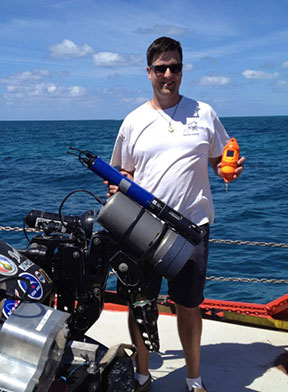
The undersea environment provides many of the same challenges as space exploration – microgravity, remote sites, finite capacity to take physical samples, limited communications, and the need for remotely operated data-gathering platforms.
Over the years, the National Aeronautics and Space Administration (NASA) has extensively funded research underwater – even under Arctic ice – to test approaches to space exploration and train astronauts.
As part of that effort, the NEEMO (NASA Extreme Environment Missions Operation) program, a joint effort of NASA, the National Oceanic and Atmospheric Administration (NOAA), and the University of North Carolina at Wilmington, has conducted annual underwater missions to fine-tune the art and science of space exploration.
“Going to space is expensive and pretty time-limited,” notes University of Delaware associate professor of oceanography and geology Art Trembanis (@PapaZissou), a NEEMO veteran and expert in autonomous underwater vehicles (AUVs). “We’ve got to go through dress rehearsal as much as possible beforehand.”
And though Aquarius Reef Base – a live-aboard underwater mockup of a space station that has been home to the NEEMO missions for the past decade – is only about six miles off Key Largo, Florida, it’s a perfect testing ground for the space agency’s remote science gathering protocols and practices.
“You’re always facing new challenges, like the Apollo 13 mission, and also new discoveries that are unexpected,” says Trembanis.
CastAway: New Frontiers
The NEEMO 15 mission, conducted in October 2011, teamed Trembanis’ instrument-loaded AUV with single-operator DeepWorker submersibles and SCUBA divers to collect a wide variety of data in a broad number of ways.
Outfitting the project’s DeepWorker single-person subs, Trembanis realized that the versatile little vehicles offered plenty of microgravity pilot training, but little in the way of data gathering.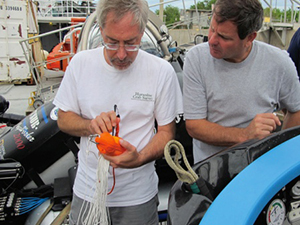
“We realized when we were out there that the DeepWorker subs were designed more for a commercial landscape than for the scientific arena, so it didn’t have a lot of science equipment on it,” Trembanis notes. “There’s a depth gauge the pilot can refer to, but no recording of data – that sort of thing. I had this little ‘aha’ moment: ‘I’ve got this CastAway unit. Can we strap it to the vehicle?’”
The CastAway CTD is a rugged, palm-sized instrument that samples conductivity, temperature, and depth, profiling the water column and computing sound-speed readings that aid in correcting a host of underwater sonar measurements.
With a flow-through measurement cell, the durability to operate as deep as 100 meters below the surface, two AA batteries for power, and an onboard datalogger accessed at the surface via Bluetooth, the CastAway is completely self-contained – a perfect fit with the NASA concept.
Accurate and Durable
Since the CastAway was introduced in 2010, Trembanis and his team have employed it to take vertical profiles that helped them determine how to ballast their AUV.
Trembanis says by the NEEMO 15 mission, the CastAway had already won the respect of the CTD (conductivity-temperature-depth) purists in his lab.
“I have some dyed-in-the-wool CTD wizards who live and breathe CTD data, and when we compared the CastAway against our two other CTDs – which are more expensive by a factor of two or three times – they were really impressed at the way the CastAway stood up to those systems,” he says.
In fact, plotting the CastAway against the industry’s gold-standard CTD, a Seabird, Trembanis said the temperature plots were almost indistinguishable from each other, and slight differences in the salinity readings from the two systems disappeared by the time the units computed nearly identical sound-speed profiles.
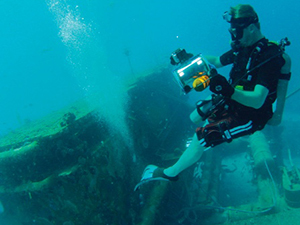
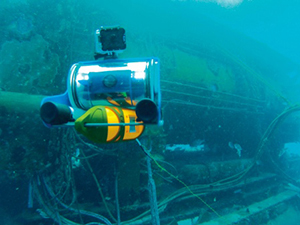
A rugged, bright-orange CastAway CTD continually gathers temperature, depth and salinity data as a diver explores a wreck. University of Delaware oceanographer Art Trembanis says the accurate GPS data from CastAway CTDs mounted on underwater cameras greatly improved image analysis following the NEEMO 15 and 16 missions.
Trembanis had no worries about the ability of the CastAway to come back intact from its “space voyage” on the reef. The instrument’s bright-orange PVC case is a familiar sight on his introductory geology field trips, where dozens of students use it to try their hand at taking field measurements.
“It definitely passes the student-approved test,” Trembanis says. “We’ve even thrown it like a football into the surf zone to get temperature and salinity readings.”
In addition to giving students the comfort of working with an instrument they’re not likely to break, the CastAway is so simple to operate that it’s a great training tool, he adds.
“With a couple minutes’ training, I can hand it to a student – the more gaming experience they have, the better – and in just a few minutes, they can show me a vertical profile,” Trembanis notes. “We can view it immediately – there’s no need to download data or anything.”
The initial point of strapping CastAways to the DeepWorker submersibles was to simply gather data for the sake of the drill. However, Trembanis notes, the precise location data from the CastAway helped the team better analyze video footage collected by the submersibles, which could aid in his ongoing study of barrel sponges. Also, the sensitivity of the CastAway yielded insight into the spatial relationships among water masses of different salinity and temperature along the reef.
“There aren’t big differences, but shades of grey can be significant in the reef environment,” he points out.
EXO2 Sonde Goes Deep
As the NEEMO 16 mission date neared, Trembanis was eager to outfit the DeepWorker submersibles with CastAways again.
He contacted YSI, to see if there was a CastAway he could borrow for the project, but he was presented with an even more exciting option – a pre-release model of YSI’s new EXO2 multiparameter advanced water quality monitoring platform.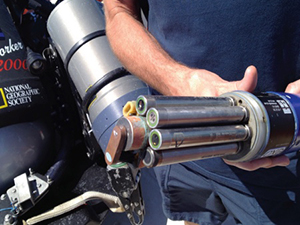
The EXO2 is a complete redesign of the sonde technology that put YSI on the environmental water quality testing map. With its completely sealed construction, six user-replaceable smart sensors, and a central wiper, the new sonde is designed for streamlined service and outstanding reliability in the field.
Designed for use as deep as 250 meters– well beyond NEEMO mission parameters– the EXO2 measures pH, dissolved oxygen (DO), conductivity, temperature, depth, turbidity, total algae (using a dual-channel sensor for chlorophyll and blue-green algae), and dissolved organic matter (using a fluorescent [fDOM] sensor).
It sounds complicated, but Trembanis says working with the EXO2 was highly intuitive. “I had several students on the expedition, and we had to spend a couple of hours one day going through the operation of the EXO2,” he recalls. “Then I assigned it to a couple of students who operated it by themselves. All I had to say was, ‘change the batteries and wave the little magnet over it until the light turns blue, then hand it over to the submarine guys so they can attach it.’ “At the end of the day, we could connect it to the laptop via Bluetooth and transfer all our data files,” Trembanis says.
“We could look at the data on the laptop while someone else was cleaning the unit. “We changed the batteries every day just to be safe, though the sonde could run for days on a set of batteries,” he notes. “We had it running continuously for five or six hours a day at its maximum rate, and it was already loaded with plenty of memory – turns out we could have conceivably set it up to run for weeks.”
That was the goal of the EXO2 team, – to create an instrument that was so efficient and so easy to use that it made calibration a breeze, made deployments more efficient, and saved users dramatically on operations and maintenance costs.
Because it’s completely sealed and has these easily replaceable sensors, the EXO2 has about double the service life expectancy of the legacy 6-series sondes it’s replacing. The smart sensors store their own calibration data – which is great not just for speeding calibration or doing all your calibration in the lab before dispersing sensors to the field, but also because then you have a permanent record that supports your field data. For data collected in the field, it’s easy to send it via Bluetooth or optional signal output adapters to the KOR interface software for easy visualization, management, and organization. And for more processing, the data can easily be transported into an Excel spreadsheet.
Magic Wand
Trembanis was enchanted by the possibilities created by the EXO2. Immediately, he recognized the opportunity to give NASA pilots a mission while gathering valuable data about the water dynamics in and around the mysterious barrel sponges that dot the reef. “We mounted it on the manipulator arm of the submersible,” he says. “I told the pilots, ‘I want you to wave it like a magic wand. Pass it over vertically, pass it up and down.”
It was no easy feat to wave the manipulator arms around, no matter how compact the sonde was – a lesson better learned off the coast of Florida than hovering over a hurtling asteroid. Undaunted, Trembanis and a colleague carried the EXO2 down to the reef in a SCUBA dive to study the flow dynamics around the huge sponges. That versatility demonstrated to Trembanis why the EXO2 is a perfect fit with his philosophy of underwater research – whether for NASA or for any other aspect of science.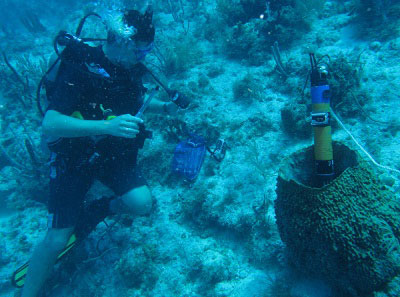
A YSI EXO2 multiparameter sonde provides an intimate look at water quality parameters inside a barrel sponge off the coast of Key West. See the video below of sponge science with the EXO sonde.
“We’re in a time of some amazing platforms in oceanography, whether gliders or ROVs or AUVs or moored systems,” he says. “That level of flexibility is great because I can say, ‘I know this sensor. All I need to know is how I bring it to work today.’”
Heyer points out that the YSI team took the very same approach when developing a multi-parameter sonde that could be deployed anywhere from wells to the ocean, in applications ranging from quick sampling to long-term, unattended deployments lasting weeks or months. Of course, they never imagined the EXO2 – or the CastAway, for that matter – would be part of the NASA space program.
“With Art, we get exposure to a lot of research capabilities we probably never would think of,” Heyer laughs. “He gives us those outside-the-box applications.”

Additional Blog Posts of Interest:
Monitoring Water Quality Interactions with Multiparameter Sondes
10 Tips to Prevent Biofouling on Water Quality Instruments
Top 5 Challenges to Collecting Water Quality Data - Challenge 1
Advantages of Smart Sensors and Ports on Water Quality Sondes